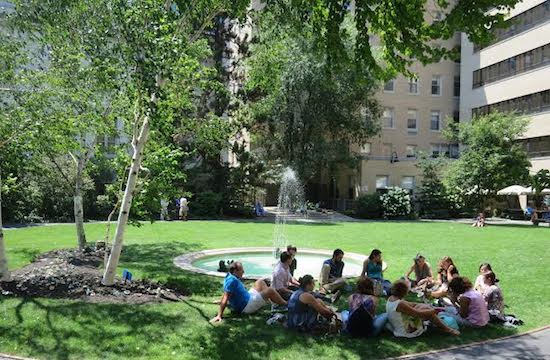
Thomas M. Paine: Save Boston Children's Hospital's healing garden
The Prouty Garden, at Boston Children's Hospital.
-- photo by Thomas M. Paine
For almost 60 years Boston Children’s Hospital considered the acclaimed Prouty Garden an integral part of its mission. The garden’s donor, longtime hospital trustee Olive Higgins Prouty, who had lost two young daughters, had the word of then-President William Wolbach that the garden she was endowing in 1956 would remain forever. That commitment is about to end unless the board quickly rethinks its plan to demolish the garden in a proposed $1.2 billion project to overhaul the hospital’s neonatal intensive-care unit and replace 82 semi-private rooms with single rooms with showers and clothing storage.
From its creation, Prouty Garden has been a sanctuary of healing where children confined for long periods can brighten their stays and hasten their recovery with daily visits to smell the flowers, discover the hidden statues, or see themselves reflected in the fountain pool. The expansive lawns, majestic dawn redwood, shrubs and perennial borders have provided respite for countless distraught families, visitors and overworked hospital personnel. Many children have spent their last moments on earth in the peace of Prouty Garden. It is where President John F. Kennedy came to grieve after the loss of his newborn son, Patrick Bouvier Kennedy. Originally designed by the famed Olmsted Brothers firm, Prouty Garden is “one of the most successful hospital gardens in the country,” according to healing-gardens authority Clare Cooper Marcus.
Prouty Garden advocates maintain that, frustrated with delay and wary of ballooning costs, the board has rejected some 17 plans that would preserve Prouty Garden. All 17 apparently had “fatal flaws.” The chosen plan was the only one considered that sacrifices Prouty Garden. Such decisions are never easy, and precisely what factors informed the decision process are not public. The board apparently, and no doubt reluctantly, concluded that Prouty Garden is not an inviolable part of the hospital’s mission but rather a temporary, expendable amenity.
To compensate for the loss, the selected design includes other landscaping. The renderings available online show a ground-level courtyard crisscrossed by walkways separated by raised planters of bamboos underplanted with groundcover. There are pocket parks in upper floors of the 11-story building, and a green roof. But does that settle the matter?
The fragmented greenspace in the preferred plan cannot compare with the expansive 23,000-square-foot Prouty Garden, with its spacious lawn under open skies, on firm ground, away from busy walkways, where kids can roam and families can find solitude. Even the largest green space in the design, the proposed outdoor courtyard, offers none of that immersive power, and the small pocket gardens on the upper levels can do even less. A green roof would hardly offer calm and security, let alone be planted with large trees or be visible from a hospital window. As to where families would go to grieve alone, or terminally ill children would spend their last moments, the proposed spaces are no substitute for Prouty Garden.
Board members have rightly emphasized the needs of the children over the needs of the hospital. But have they adequately considered how the garden itself serves children’s needs? Environmental psychologist Roger Ulrich demonstrates that experiencing nature in a hospital garden even for five minutes can speed healing significantly, that hospital gardens are especially effective for calming stressed patients, family members, and staff, and that patient exposure to nature reduces health-care costs.[i]
But scientific facts don’t tell the whole story. The personal testimonials posted at saveprouty.org offer compelling evidence of the difference that Prouty Garden has made. Shelley Senai tells what happened after her daughter Juniper was born with protruding bowels: “All told, we spent 101 days living at your hospital during the summer of 2013 and I can’t think of a day that we didn’t spend in the garden, unless it was raining….We met other parents there and got a feel for the community that was happening in this big hospital around us.” Caitlyn O’Hara, a lifelong cystic fibrosis patient who has relied on Prouty Garden for three decades and is waiting for a lung transplant, says pocket gardens and roof gardens do not compare: “A manufactured rooftop garden, no matter how lovely, cannot replace the magic of the natural world.”
More than 11,000 patients, families, staff, donors and community members have signed a change.org petition to preserve Prouty Garden. While they recognize the need for the proposed new hospital facilities, they argue that the garden, which is no less essential to its patients, patient families, nurses, physicians and other medical personnel, can and should be saved. Prouty Garden advocates are raising funds to press their case in ways that the board cannot ignore.
In New York City, trustees of the Frick Collection, a private art museum, recently decided to rethink expansion plans that would have eliminated the museum’s beloved garden for needed building space. If people were up in arms about the loss of a museum garden, how much more compelling and deep are the feelings evoked by the imminent loss of a hospital garden for sick and ill children.
I urge the hospital administration to declare a moratorium and go back to the drawing board. Surely, talented architects can produce a plan that avoids substantially altering the outdoor space that has been indispensable for the past six decades. Prouty Garden, which was intended to last forever, is about to be lost forever, unless the board changes course.
Thomas M. Paine, a landscape architect, is the author of Cities with Heart, about the importance of public open space. In 1976, he designed a corner of the Prouty Garden when he was an associate at Shurcliff, Merrill & Footit. He was a patient at the hospital in 1952.
